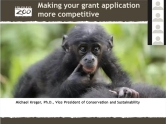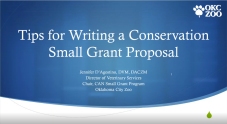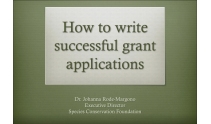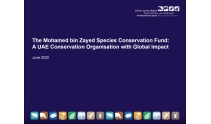Money, money, money… we are always struggling to find resources for our conservation programs, so many times we need to write and request grants from other institutions.
In this short webinar series, developed by the Amphibian Ark, grant managers from different organizations share advice on what a good/successful proposal is for them, regardless of the guidelines of the organization they represent. From the many applications they receive each year, they discuss which stand out over others, what is the key to success, what they are looking for as reviewers and granting bodies in a well-written proposal. This information from organizations that provide grants is a way to give our audience tools to write better proposals, not only to apply for AArk grants, but also to other organizations. Each session runs for between 30-40 minutes.
The following presentations were delivered over the course of the series. Click on each video image to view the presentation. The complete set of videos is also available as a playlist on YouTube.

Making your grant application more competitive Michael Kreger The Columbus Zoo invites proposals ranging from $5,000-$20,000. Pre-proposals which include a brief description of the proposal must be submitted initially, to ensure that the grant is a good fit with the grants program. Successful applications often include working with local people, education components, and has some on the ground impact on wildlife. The Columbus Zoo Fund for Conservation integrates conservation research, local community involvement, capacity building, environmental education, and behavior change leading to improved conservation of wildlife and habitat. |
Grant writing webinar videos
Brenda Stringer Applying for grants is closely aligned with other types of fundraising, and requires the applicants to do their research about the organization you are applying to for your funding. It is important to understand they organization, and the types of projects they usually provide funding for. The Wildlife Conservation Fund from the John Ball Zoo was established in the mid-1980s and since then, thousands of funding applications have been received. This presentation provides advice on how to prepare a successful grant application. |

Tips for writing a conservation small grant proposal Jennifer D’Agostino This presentation explains the small grants program for conservation research provided by the Oklahoma City Zoo, with some examples of successful grants, and why they were funded, as well as examples of some unsuccessful applications. It includes advice on how to improve application to increase the success of them being funded. |

How to write successful grant applications Johanna Rode-Margono Writing successful grant applications depends on many things, including selecting the most appropriate donors, preparing your application, and determining what to include in your proposal. This presentation includes examples of proposals that the presented has written, and proposals that have been received for funding by the Amphibian Fund of the Species Conservation Foundation. |

The Mohamed bin Zayed Species Conservation Fund Nicolas Heard The Mohamed bin Zayed Species Conservation Fund is a foundation which began providing grants for all types of species conservation in 2009. Up to 1,500 proposals are received each year, and these are reviewed during three separate funding time frames, but only around 10% of these proposals actually receive grants, since the fund have a limit of US 1.5 million per year. |

Amphibian Ark conservation grants Kevin Johnson The Amphibian Ark Conservation Grants program provides small grants to start-up conservation breeding programs. Each year, up to 20 applications are received, and although most of them are excellent, some could have been much better, and therefore more likely to receive funding, if a few simple guidelines had been followed. This presentation shares some of suggestions for improving applications, and making sure your application is more likely to be considered for funding. |







